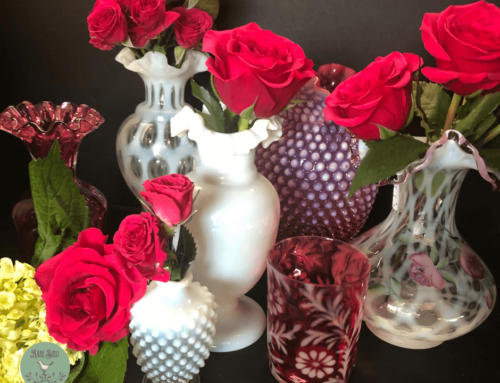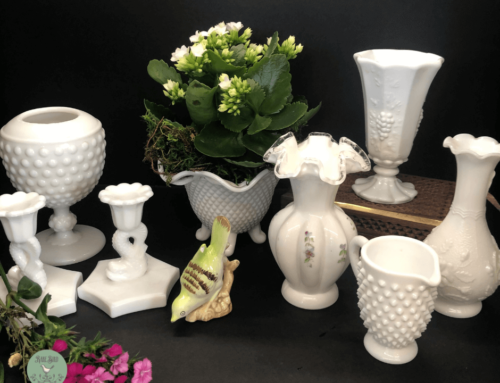In this guide to collecting depression glass, Rare Bird Antiques want to cover the history of this glassware and offer you some valuable information you need to know to collect it. Depression Glass is so named because it came out of the Great Depression. When the stock market crashed on “Black Tuesday” in 1929, the world changed. Families had to scrimp and save any way they possibly could to survive. People could no longer afford fine china and crystal and in many cases had to sell what they owned to feed their families. Families still wanted and needed cheer and they turned to their homes to find it.
Manufacturing
American glass makers had to recreate themselves also. They could no longer afford to produce highly detailed fine crystal and they turned to producing affordable glassware in cheerful colors. Manufacturers such as:
were among twenty companies producing this glass in around 100 different patterns.
The glass was made by pouring liquid glass into pre-made molds. Typically, the pieces were not polished and some even had rough edges. The manufacturers could produce 1000 pieces a day with their machines. Because of the mass production, many imperfections like bubbles, molding flaws and inconsistency of color were quite common. You will see seams on depression glass. Because of the fast production, the glass would slip in the mold causing noticeable seams. According to Invaluable, the flaws tend to be cherished by collectors today and do not negatively effect the value of the pieces.

Colors
Each manufacturer developed their own colors and shapes. The glass was produced in many colors. The common colors include pink, pale blue, green and amber. Less common colors include canary (yellow), ultramarine, jadeite, delphite (opaque pale blue), cobalt blue, red, black, amethyst, monax (opalescent white), white (milk glass) and uranium glass. The patterns often mimicked traditional crystal. The glassware included all kinds of pieces from plates, cups and saucers, to punch bowls and ash trays. The color helped to disguise the lower quality of the glass. These cheerful colors provided the aesthetic Depression era housewives were looking for. According to Dixie Davis, the president of the Arizona Depression Glass Club in a quote in The Arizona Republic in 1986, “Color was very important in Depression Glass because those were such dark days.”
In an article by Apartment Therapy, the “colored dishware may have also helped to make plain, meager meals look more appetizing. With economic strife often comes lackluster dishes, but even beans and bread looked almost restaurant-worthy on pink glass plates. ‘In the present era, with glass so pronounced a vogue, it is not difficult for the homemaker to have the dining table as refreshing in appearance as in substance,’ the Lincoln Journal Star reported in 1931. ‘Color glass serving dishes can lend zest to otherwise plain viands and aid in making them appeal to the appetite.’”

Patterns
As we mentioned, there are around a hundred different patterns of depression glass. Some of the most popular patterns are:
 |
American SweetheartCompany: MacBeth-Evans Years Produced: 1930 – 1936 Colors: monax, pink, deep red, cobalt – most commonly pink |
 |
CameoAlso know as: Dancing Girl & Ballerina Company: Anchor-Hocking Years Produced: 1930-1934 Colors: green, yellow, pink, clear with platinum rim – most commonly green Most valuable: pink and yellow due to limited production |
 |
IrisCompany: Jeanette Glass Company Years Produced: 1928-1932 and again in late 1940’s -1950’s Colors: clear, iridescent, pink, marigold, amber |
 |
MayfairAlso know as Open Rose Company: Anchor-Hocking Years Produced: 1931-1937 Colors: pink, blue, yellow, green – most commonly pink Most valuable – blue |
 |
PrincessCompany: Anchor-Hocking Years Produced: 1931-1934 Colors: pink, green, topaz |
 |
Royal LaceCompany: Hazel-Atlas Years Produced: 1934-1941 Colors: green, pink, crystal, cobalt blue Most valuable – cobalt blue because it was only produced from 1936-1941 |
Affordability
According to Architectural Digest, the average family income dropped 40% during the Great Depression. There was little spare money lying around for home décor. There was little money to spend on anything. Companies used depression glass to entice sales. Grocery stores, gas stations, and movie houses would offer pieces as free gifts for loyal customers. You could find a cup and saucer in your box of oatmeal and if you bought a refrigerator, you could get a topaz luncheon set from the Lancaster Glass Company. If you needed a serving piece that would not fit in a cereal box, you could shop the local five-and-dime and get them for fifty cents. Glass manufacturers could sell a twelve-piece set for less than $2.00 which added to the popularity of depression glass.

Manufacturing Marks
The majority of depression glass was not marked but according to an article by Alexander Churchill of Martha Stewart, “the lack of identification doesn’t necessarily have a bearing on the authenticity of the piece.” Carnival Heaven offers a nice list of glass maker marks.
Because you cannot rely on identifying the maker by a mark, you have to rely on the patter. Great resources are the National Depression Glass Association. The Collector’s Encyclopedia of Depression Glass by Gene Florence and online pattern guides like the one offered by The Spruce Crafts.

What to Look For
You want to check pieces for damage. Look for obvious indications of damage like chips and cracks of course. If you hold a piece to the light, cracks will be more visible. Pay special attention to the handles on pitchers, creamers and cups. Run your fingers around the edges to be sure there are no chips.
Keep in mind that depression glass was used. It is extremely rare to find a “perfect” piece and in fact, perfection may indicate a reproduction. Remember, you will see seams and you may see bubbling, molding flaws and inconsistency in color as we mentioned before. Because it was used, you may see knife marks but these do not necessarily detract from the value as long as the piece is not heavily marked.
Look out for “sick glass” – a condition of cloudiness that is permanently etched into the glass by automatic dishwashes. Sick glass cannot be restored and significantly decreases the value. Careful inspection is needed to determine if the cloudiness is sick glass or water rings. Water rings are evidence of evaporation and can often be removed. Depression glass is quite durable and has been around for over 100 years despite imperfections. If you decide to collect it, we recommend you use it, but hand wash it – don’t put it in the dishwasher. It is too pretty to just sit on a shelf.


